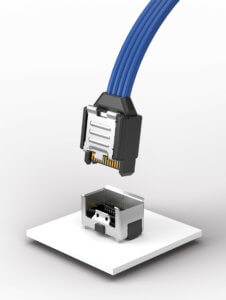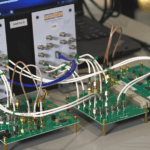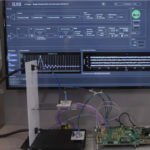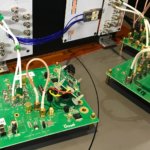
DesignCon 2018 has passed. For those involved from the high-speed communications and semiconductor communities, everyone needs time to catch their breath a bit before planning for the rest of 2018.
Why? DesignCon always offers exposure to the latest state-of-the-art design methodologies, applications, technologies, and unparalleled networking opportunities. One question was on the minds of many: How real is 112 Gbps PAM4? The number of demos and presentation at DesignCon prove the answer.
112 Gbps PAM4 Technical Presentations
Faster data rates and new modulation schemes likely will require new testing and characterization specification. Richard Mellitz – Samtec Distinguished Engineer – argued this in his DesignCon presentation: “Effective Return Loss for 112 G and 56 G PAM4“.
Effective Return Loss (ERL) is a single value instead of typical RL masks used in the frequency domain. The basis for ERL is using pulse echo TDR instead of a step function TDR. The resultant single symbol response is convolved with the modulation signal levels to produce an effective reflection coefficient metric at a specific BER. Converting to dBs produces ERL.
Another presentation detailed proper DC-block capacitor modeling at 56 Gbps NRZ and 112 Gbps PAM4. Scott McMorrow – Samtec CTO of SI – and Scott Neally – Samtec SI Consultant – explained why DC-blocking capacitors must present a high bandwidth, near-reflectionless transition to the signal in their presentation “Designing DC-Blocking Capacitor Transitions to Enable 56 Gbps NRZ & 112 Gbps PAM4“.
Please contact Samtec SI technical experts at [email protected] for more information on ERL and proper DC-blocking capacitor modeling.
Product Demonstration: Credo 112 Gbps PAM4 SerDes
Credo Semiconductor is a global innovation leader in SerDes technology. DesignCon 2018 was a launch party for their 112 Gbps PAM4 SerDes solutions.
Many applications, including data centers, enterprise computing and HPC, require next-gen SerDes for increased channel data rates. Credo’s 112G PAM4 solutions provide a foundation for next-gen channel data rates the market is looking for.
Long reach solutions – whether PCB traces or Flyover cable applications – demand robust signal integrity. The combination of Credo’s SerDes with Samtec’s AcceleRate® Cable solutions offers an ideal proof-of-concept for long reach signals over cable.
Product Introduction: NovaRay™ High-Bandwidth, High-Density Array
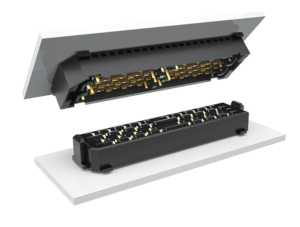
Samtec’s NovaRay™ is an industry-leading high bandwidth, high-density interconnect system. The pin-to-ground differential pair configuration enables very low crosstalk to 40 GHz+, tight impedance control, and minimal variance in data rate as stack heights increase.
The system is 112 Gbps PAM4 capable and is rated up to 56 Gbps NRZ per channel. It boasts an industry-leading aggregate average data rate of 1.33 Tbps per square inch. This extreme performance and density is critical as system sizes decrease while speeds increase.
Two highly reliable points of contact contribute to the 112 Gbps PAM4 capabilities, and ensure a more reliable connection, with stub-free mating. The 92 ohm impedance rating addresses both 85 and 100 ohm applications. An improved breakout region has been developed using a new offset signal-to-ground configuration.
For more information, please visit www.samtec.com/novaray.
112 Gbps PAM4 – What’s next?
112 Gbps PAM4 SerDes technology will continue to expand as 2018 progresses. Xilinx demonstrated a 56 Gbps PAM4 transceiver test chip, so the FPGA vendors have roadmap solutions for next-gen applications.
There remains a need for 100 Gbps+ physical layers across the data center. There may be single lane, double lane or quad lane solutions proposed. PHY applications include copper cable and backplane. Expect to see additional details from the Standards communities on this efforts.
The response of many is that 112 Gbps PAM4 applications ARE real. The demonstrations and presentations confirm the reality. The buzz on the floor at DesignCon surrounded the real, ongoing design-in efforts at the tier 1 data center equipment providers. Market and customer acceptance of new technologies provide the best proof of all!
